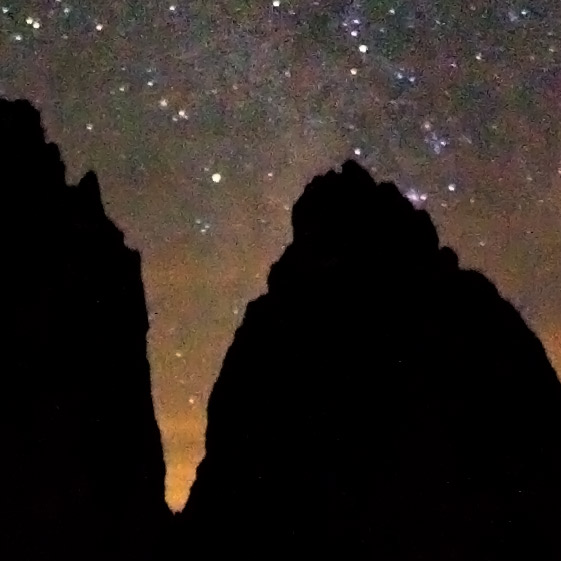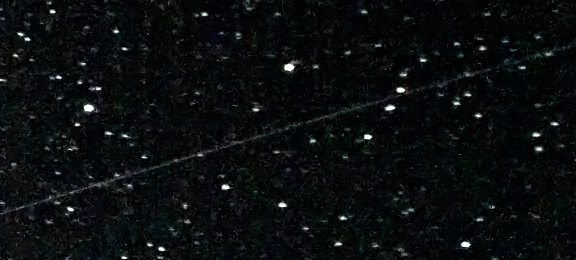The Milky Way at ISO 3200
The Milky Way at ISO 3200, testo e foto by
Juza. Pubblicato il 08 Giugno 2012; 1 risposte, 6154 visite.

Canon EOS 40D, Canon EF-S 10-22mm f/3.5-4.5 USM, 30" f/3.5, iso 3200, tripod. Dolomites, Italy.
I had envisioned the scene for a lot of time, but for many reasons, I wasn't able to take this photo until a couple of weeks ago. Sometimes the sky was cloudy, other times there was the Moon or other lights so the Milky Way was not visibile, other times I was not in the right place, and so on...
In my latest workshop in the Dolomites, instead, I have been greeted by a Moon-less, cristal clear night. A great occasion to test the capabilities of my new Canon 40D and to take the photo that I desired so much! But taking a photo of the Milky Way is not easy: the first challenge is framing the photo. After half an hour in the darkness, my eyes got used to the night, and I managed to make an approximative composition with the Canon 10-22mm, that I used to capture a wide view of the sky. The Three Peacks are a great compositional anchor - even though they are featureless silouettes, their peculiar shape adds a lot to the photo. I had to frame the photo through the viewfinder; live view does not work in the darkness, it gives just a black image into the LCD screen.
Once I had composed the photo, I had to choose the exposure. For night photography, I always use manual mode; the evaluative meter of the camera does not work. I've choosen an exposure of 30", ISO 3200 and aperture f/3.5, that is the widest aperture of my 10-22mm at the 10mm setting. This lens is razor sharp even at f/3.5 in the center; the corners are a bit soft at this aperture, but for this kind of photos I really don't care about corners!
Why 30" at ISO 3200? The Milky Way is a very fainth subject; you need an extremely long exposure of high sensitivity to capture it in photo. I could have used a 60" exposure at ISO 1600, or 4 minutes at ISO 400, but the stars would have been blurred due to Earth rotation; sometimes this blur makes the photo more interesting, but here I wanted to take a sharp photo of the sky. 30" is already a very long exposure, but with a focal length of 10mm there is not star trail, while with a longer lens, that has a narrower field of view, the stars would have been blurred - the longer the lens, the more you get star trails.

A 100%, processed, crop from the lower portion of the photo. Of course there is some noise, but the image quality is still pretty good - and in a 12x18" the noise is barely noticeable.
You should not be shy to use extremely high ISO sensitivities - many partecipants of my workshop were surprised when I told them that I was shooting at ISO 3200, but sometimes high ISO is the key to take otherwise impossible photos. The Canon 40D is not the most noiseless camera on the market (wish I had a Canon 1DIII or a Nikon D3!), but it is still quite good at ISO 3200. Of course some noise reduction is inevitable, but in a photo like this one, that has not low-contrast detail, it is relatively easy to reduce the noise; here I applied a couple of times the "Reduce Noise" filter of PS CS3, with Strenght 10, Preserve Detail 40%, Reduce Color Noise 70%.
But it is not enough to nail exposure, composition and post-processing to get a good photo. At f/3.5, even with a 10mm wide angle you should pay attention to focus: since the viewfinder is so dark that you can barely compose the photo, how can you fine tune the focus? The only way to get a sharp photo is to set the lens on manual focus, and to rotate the focus ring close to the "infinity" mark. This mark is very approximative - it takes into accound the thermal dilatation of the lens, and many times you achieve the correct focus a little before the mark - if you rotate the focus ring in correspondence with the mark, it is likely that the photo will be out of focus, because you have actually focussed "beyond infinity".

The "misterious" streak...a plane, a meteor, a satellite? I had to take various test shots, and every time I changed slightly the position of the focus ring, until I found the perfect setting, that gave me a sharp photo even when I observed the file at 10x magnification on the big, bright 3" LCD of my camera.
Finally, I got the photo I was hoping for. The image itself revealed some fascinating details that I could not see by naked eye - the most prominent one is for sure the orange light behind the mountains. It is likely that it is the light from the distant villages of Misurina and Auronzo, and it was so fainth that I did not see it at all until I toke the photo. Other than that, the 3200 ISO exposure revealed a countless number of stars! (and yes, they are actually stars - even at ISO 3200, with a modern camera as the 40D there are not hot pixels!). The photo even captured a long, thin streak - it could have been easily cloned out, but I've choosen to leave it in the photo, since it is another element of interest, it may be a meteor!
Don't be shy to experiment and to use your camera at extreme settings! Image quality is important, but sometimes it is worth to trade a bit of IQ for an unique photo.
Risposte e commenti
Che cosa ne pensi di questo articolo?
Vuoi dire la tua, fare domande all'autore o semplicemente fare i complimenti per un articolo che ti ha colpito particolarmente? Per partecipare iscriviti a JuzaPhoto, è semplice e gratuito!
Non solo: iscrivendoti potrai creare una tua pagina personale, pubblicare foto, ricevere commenti, partecipare alle discussioni e sfruttare tutte le funzionalità di JuzaPhoto. Con oltre 242000 iscritti, c'è spazio per tutti, dal principiante al professionista.
| inviato il 03 Marzo 2013 ore 14:56
Thank you for the education Juza and the nice photo of the Milky Way with the Dolomies in silhouette. I also have the 40D and the 10-22 f 3.5. I have never used the 3200 ISO setting but I will certainly try some sky pictures whenever I go camping in the summer time. There is too much light pollution where I live and I have to go far Northward away from the cities to get clear skies with stars.
As a newcomer to your web site I am slowly finding my way around all the various forums.There are so many talented and wonderful photographers like yourself here, and I have to learn all the tricks for PostProcessing and noise reduction etcetera. Regards. Jim. |



 JuzaPhoto contiene link affiliati Amazon ed Ebay e riceve una commissione in caso di acquisto attraverso link affiliati.
JuzaPhoto contiene link affiliati Amazon ed Ebay e riceve una commissione in caso di acquisto attraverso link affiliati.